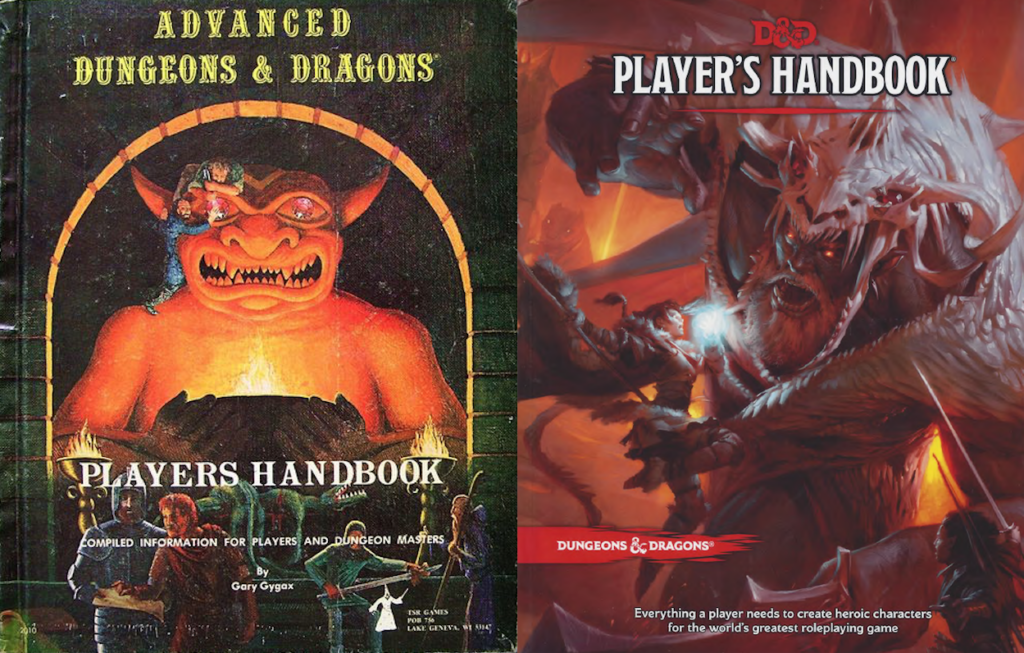There’s often a lot of shade thrown at Dungeons & Dragons 5th Edition from OSR folks and fans of earlier editions like 1st, 2nd, and Basic. I bow to no one in my love of 1st Edition AD&D, but I’ve played 5th edition as well, and I think there are some 5E things that would work fine in a 1E or 2E game. Here are my choices.
3. Skill Checks. This is something that Judges Guild experimented with back in the 70’s, albeit not in quite as finished a form as you see it in 5E. This is actually something I included in Adventures Dark and Deep™, and it’s really handy. It’s no different than a DM saying “roll a d20” when a player wants to do something wacky, except you try to roll under the relevant statistic, and the DM can apply some broadly applicable modifiers. I suggest -10 for a simple task, -5 for a hard one, and no modifier for a really hard one.
2. Legendary Actions. Giving special advantages to certain monsters in their home territory is a rather obvious notion, and it’s odd that it hasn’t been more widely applied before 5th edition. Big, special monsters in 1E, like liches and ancient dragons, deserve a little buffing like this. 5E might go a little overboard with the power level (as it usually does), but the principle is a sound one. I could especially see this sort of thing for treants and unicorns in sylvan woodlands, cloud giants in their cloud castles, and so forth.
1. Advantage/Disadvantage. As a mechanic, this is a pretty simple thing for a DM to apply, and it would work exactly the same in 1st or 2nd edition as it does in 5th edition. The question is when to apply it; earlier editions rely on plus and minus modifiers to a d20 roll. At what point does that modifier equate, more or less, to the probability changes incurred by rolling two dice? Fortunately other folks have already done the math; advantage is roughly equivalent to +4 on a d20 (and thus disadvantage is equal to -4). When you stack up the bonuses from strength, magic weapons, and situations, it at least gives the DM a framework to use it. If someone would normally have a +4 to hit (not unusual for mid- to higher levels), they can get advantage and not mess the math up too much.
What about you? Is there anything from 5E you’ve used in your earlier-edition games?










I have not been able to really wrap my head around 5e, but I have watched enough live streams that I came to like the advantage/disadvantage mechanic. I have yet to use it, but that’s only because I have not gone to the trouble of examining it deeper. Thanks to your blurb here and the link you provided, I will get to do that.
I recall one of our neighborhood DMs (who moved away after only playing with his family for a year or so) used something similar to the skill checks in his AD&D games. I wonder if he used JG’s or used them as inspiration for his own. I never saw his name appear in Dragon Magazine, etc., so I can only assume they remained “his” house rule.
I’ll have to look into Legendary Actions more. I do not recall seeing them in 5e at all, but that’s not surprising because I only glanced at the rulebooks long enough to decide they weren’t for me.
The strength of the Advantage/Disadvantage system lies not so much in the actual math of the bonus it gives – nothing stopping me from giving a +4 / -4 to any given die roll. Its real strength lies in its flexibility in offering a player an ad-hoc buff or de-buff (“Sure you can try to do The Thing, but I’m giving you disadvantage” / “OK yeah that seems straightforward I’m giving you advantage because of [x].”) WHILE STILL ALLOWING FOR SPECTACULAR AND CINEMATIC FAILURE / AGAINST ALL ODDS SUCCESS.
As deployed in 5e it’s a reward for good roleplaying (via the inspiration mechanic, which is also not a bad thing to bring over to 1e or B/X tbh), offering an incentive for the PCs not to be simply cartoonish murder hobos.
Yes, I’d chime in with Inspiration, as well. I like incentivizing good play.
I fully agree with 1) and 3) and will also use it in my upcoming Greyhawk 1e campaign. Every -4 and +4 will be replaced by (dis)advantage because it is such a simple and quick method. I really like it.
I have no experience with Legendary Actions so I cannot comment on that.
I think the idea of preparing spells to cast instead of memorizing spells in specific slots gives more flexibility to MUs and is less cumbersome than playing 1e with cantrips or extra spell slots for high INT.
Good list. The one thing on legendary actions is that, depending on the encounter, their repeated use starts to feel too much like a video game. Once the players figure out the cool down it’s almost like looking for the flash on an arcade game. Not over-using the lair actions is an easy solution, or having more than one to give it variety.
Yeah, that roll with advantage/disadvantage thing is nice. Handy alternative to a + or – modifier roll.
The roll under skill thing, didn’t 1st edition introduce that with non-weapon proficiency? I know we played it that way back in the day, but I can’t recall if it was in the rules or if we just adopted it as a logical house rule.
I have run 1E, But I am a child of 2E, and it is my fav rule set for D&D. I have played 5E 15 to 20 times over the past two years, and I fully agree with you on the three rules to bring to 1E/2E. My biggest problem with 5E is the initiative roll, which is sort of like the 1E initiative system, I like chaos in my combat, so I would bring the 2E initiative system to 5E when I run it.
I would bring one other rule to both 1E/2E, and 5E and that is the minions 1 hp one-hit kill for epic hack and slash combat on an epic level without TPKing your party.
I’ve never understood the need to have a separate rule defining minions. Why not just give your kobolds and xvarts and giant rats 1 h.p. each and call it a day?
I’d prefer modifiers to DCs or the actual die rolls because they’re probably more flexible than advantage/disadvantage. The 3E Player’s Handbook cites the example of a PC trying to befriend a group of dwarves. The player rolls high enough to meet the DC for most of the dwarves, but not high enough to meet the DC for their leader. Most of the dwarves trust the PC, but their leader is still suspicious.
The skill check system is probably one of the best things Mr. Bloch added to Adventures Dark And Deep. It’s one of those things that allows players to customize their characters more and distinguish them from each other even if they have the same class.
This might sound blasphemous, but I’m wondering if certain feats or combat options like Combat Expertise, Cleave or Power Attack could be ‘reverse-engineered’ for earlier editions and become abilities fighters could choose from as they level up. This would give fighters some more strategic options (should I sacrifice defense for offense?), some more diversity between them and avoid the “Linear Warriors, Quadratic Wizards” trope where wizards have all sorts of cool spells and abilities to look forward to as they level up but fighters generally don’t.
One thing I think should be brought forward from 1E and 2E to later editions is the return of the one-minute combat round. When I watch the Critical Role streams, it always strains disbelief for me that everyone can have all their dialogue and actions, including reacting to what other characters say and do, all within six seconds. I have a much easier time buying that all this stuff happens in a minute.